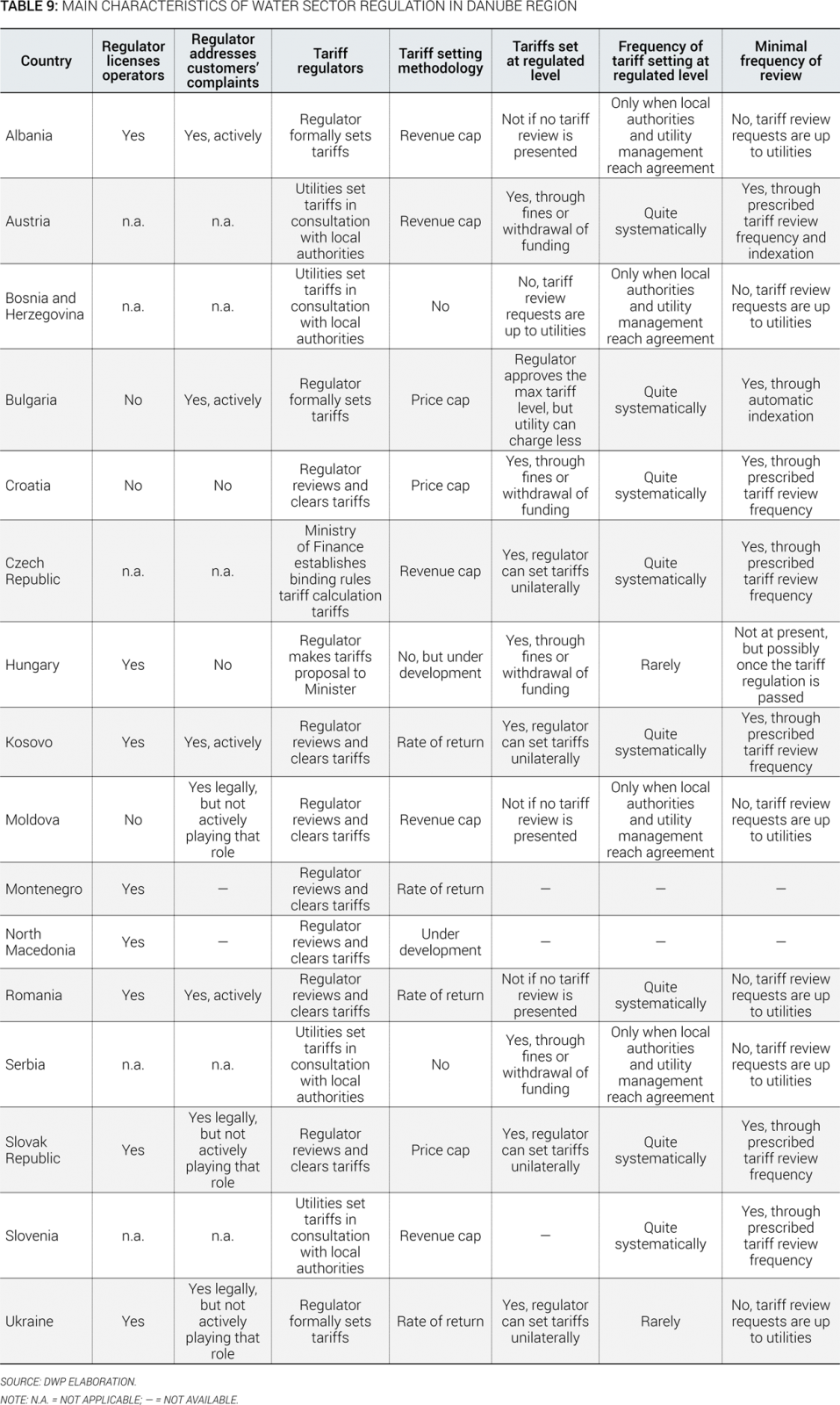D. Regulation
38. Different models of economic regulation coexist for WSS services in the Danube region, but there is a continued trend toward increased central level regulation, with Macedonia and Montenegro recently adding in 2016 water sector competencies to their national energy regulatory agencies. Austria, Slovenia, and Bosnia and Herzegovina continue to rely on self-regulation at local level, while the Czech Republic has resorted to regulation at the national level, embedded into the duties of several ministries. In Serbia, there is no economic regulation in place, whereas the remaining 11 countries in the region have all set up a national regulatory agency. Among the latter countries, there are six water specific regulators (Albania, Croatia, Hungary, Kosovo, Romania, Slovak Republic). In Moldova, Bulgaria, Macedonia, and Montenegro, the agency also regulates the energy sector, and in Ukraine it regulates other local public services. The Czech government is presently considering setting up a national regulatory agency for the WSS sector. This discussion is taking place at interministerial level and within the Ministry of Agriculture. Moreover, the Strategy of the Ministry of Agriculture of the Czech Republic with a View to 2030 (2016), includes the elaboration of a feasibility study to set up the national regulatory authority for WSS services. However, the high level of fragmentation of the Czech water sector might need to be addressed prior to establishing a national regulatory authority to ensure its future effectiveness. Presently, regulatory functions in the WSS sector are being performed by the Department of Supervision and Regulation of Water Sector of the Ministry of Agriculture.
39. All regulatory authorities in the region oversee tariff regulation either through formal tariff setting or through tariff review and clearance. The Hungarian regulator is the only regulator to solely have an advisory role in the tariff setting process. In countries with self-regulation, tariff setting is performed either by national or local governments. In addition, there are a diversity of enforcement processes to ensure that tariffs are set according to regulated levels. Two-thirds of the regulatory authorities are also in charge of licensing operators. Table 9 presents the main characteristics of water services sector regulation in the Danube region.
40. Among the 11 national regulatory authorities, nine are members of the European network of water regulators (WAREG). Created in 2014, WAREG brings together 29 regulatory authorities to promote best practices, cooperation, and knowledge sharing. In this perspective, the network has recently produced three comparative reports on institutional regulatory frameworks, public consultation practices and affordability schemes among its members (see box 3).
Box 3 WAREG’s Role in Water Supply Regulation
Water sector regulation in Europe encompasses a rich diversity of institutional frameworks and market conditions that differ from country to country. In a context of significant evolution toward the rationalization of the sector and the harmonization of practices and principles, national water sector regulators have identified the need for a joint effort to address common challenges for the sustainability of these services in Europe. WAREG was created in April 2014 by an initial group of 12 WSS regulators. The common objectives of the network include:
- Exchanging common practices, information, joint analysis, and comparisons of existing water supply sector regulatory models and performances of water utilities.
- Organizing specialized training, technical assistance, and exchange of know-how and experience.
- Promoting best practice and stable regulation of the water supply sector at European level for WSS services;
- Promoting cooperative activities aimed at analyzing the sustainability of the services, adequate infrastructure investment, proper service quality standards, and consumer protection.
- Conducting an open dialogue with other relevant regional and international organizations and national institutions with particular focus on European issues in the field of water services.
At present, WAREG is made up by 25 regulatory authorities with member status and four regulatory authorities with observer status.
41. Drinking water quality is commonly regulated by the health ministry or agency in all countries, while environmental regulation regarding discharge permit or water resources use is the responsibility of an environmental ministry or agency. In new EU member states, health and environmental standards are compliant with EU water-related legislation as transposition is completed in all countries. In Austria, some of the standards applied are more stringent than EU ones, especially for wastewater discharge. Candidate and potential candidate countries mainly rely on national standards with a view to move toward convergence with EU standards. Bosnia and Herzegovina is currently harmonizing discharge standards inherited from the Republic of Yugoslavia with EU and World Health Organization (WHO) norms. Kosovo reports to have transposed approximately 95 percent of the EU DWD.

